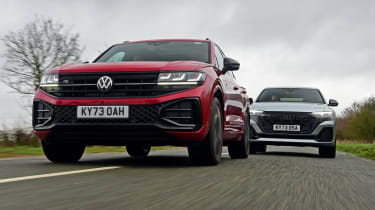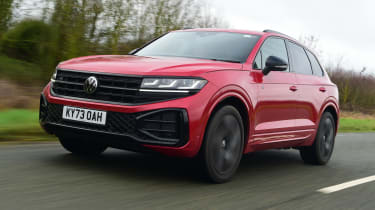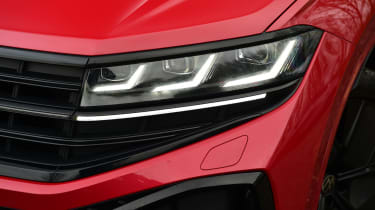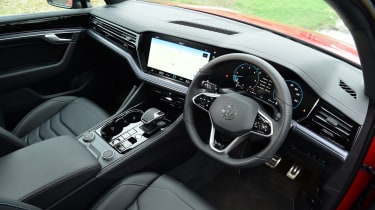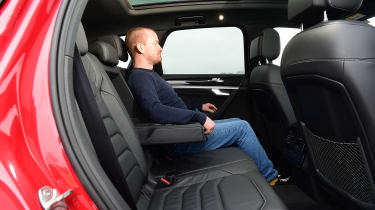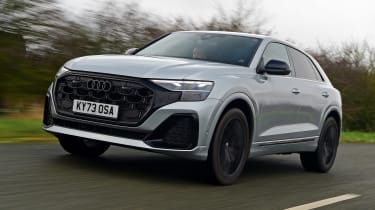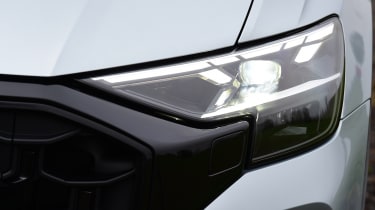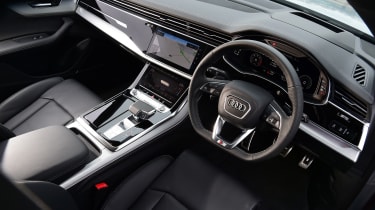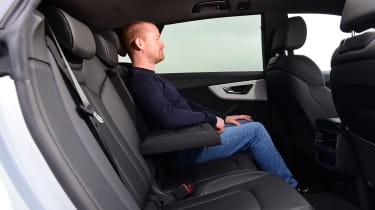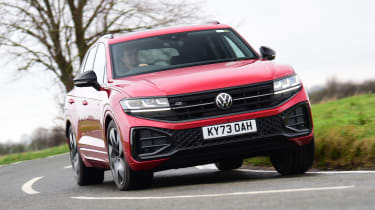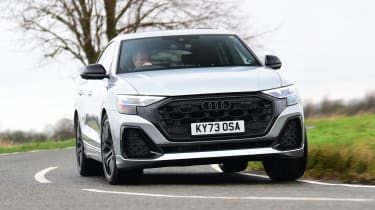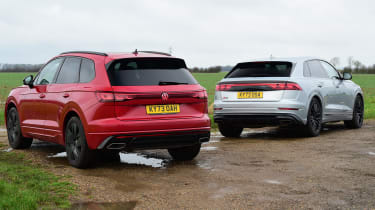Volkswagen Touareg vs Audi Q8: an SUV sibling rivalry
The updated Volkswagen Touareg and Audi Q8 are premium SUVs that share plenty of tech with each other – but which is best?
Technology sharing is common in the motoring world. Whether it’s individual components – such as the Maserati MC20 supercar using the same internal door releases as a Fiat 500 – or platform sharing, you don’t need to look far to find similarities between apparently different cars.
The Volkswagen Group has long been a master of using its tech in a variety of applications, and its MLB Evo platform – for vehicles with a longitudinally mounted front engine – is a prime example.
At the top of the tree it underpins luxury SUVs such as the Bentley Bentayga and Lamborghini Urus, but much of the same tech can be found in the recently revised Volkswagen Touareg. The nip and tuck aims to keep things fresh, and the same applies to the MLB-sharing Audi Q8. With both cars having so much in common, is the lure of a posh badge worth it? Or does the VW offer everything you really need?
| Volkswagen Touareg 3.0 TDI 4MOTION Black Edition | Audi Q8 50 TDI quattro Black Edition | |
| Price: | £70,460 | £77,770 |
| Powertrain: | 3.0-litre V6 turbodiesel, 282bhp, 4WD | 3.0-litre V6 turbodiesel MHEV, 282bhp, 4WD |
| 0-62mph: | 6.4 seconds | 6.1 seconds |
| Test efficiency: | 32.0mpg/6.6mpl | 30.1mpg/7.6mpl |
| CO2: | 215g/km | 219g/km |
| Annual VED: | £570 | £560 |
Volkswagen Touareg
The Touareg tested here is in Black Edition trim. With an optional power-folding towbar with trailer assist (£1,195) and Chilli Red paint (£1,100), our test car comes to a total of £72,665.
Tech highlights
One of the benefits of the VW Group’s MLB platform system is the huge access to technology that it brings. There are a wide range of suspension and powertrain configurations, and the Touareg takes advantage of this with air springs, active anti-roll systems, four-wheel steering and an electronic differential lock. However, none of this tech is as advanced or involved as the kit at the disposal of a Bentley Bentayga, for example.
For the revised Touareg, VW has introduced more distinct differences between the driving modes, so there is a pronounced change in the behaviour of the air suspension and adaptive dampers when switching between Comfort and Sport settings.
Last year, diesel-powered models made up 7.5 per cent of the UK new-car market. While that’s not a patch on what they once occupied, it’s still a tenth of a percentage point ahead of plug-in hybrid vehicle sales, and diesel still makes sense in large SUVs such as the Touareg. It has a 3.0-litre V6 turbo unit with 282bhp and 600Nm of torque, which arrives from just 1,750rpm and continues through to 3,250rpm. However, unlike in the Audi, there’s no hybrid assistance for the Touareg’s diesel.
Safety: The Touareg was awarded five stars by Euro NCAP in 2018, so it will need to be retested this year for it to have an up-to-date rating. Among its many standard features are curtain airbags, lane-keeping assist and traffic-sign recognition, while the revised model has a roof-load sensor, which adjusts the air suspension to account for a higher centre of mass, when a roof box is loaded, for example.
On the road
There's a clear focus on comfort in the way that the Touareg behaves on the road, which makes perfect sense for a car of this size.
Around town: There’s no disguising the Touareg’s large size at low speeds, and it’s big and unwieldy when parking. The car’s weight can be felt when moving off, too; the V6 diesel and eight-speed gearbox use an appreciable number of revs to get the wheels rolling. The ride is smooth, but doesn’t keep side-to-side movements tightly controlled at low speeds, so you’ll occasionally feel like your head is being rocked around.
A & B-roads: A twisty B-road isn’t the Touareg’s natural home. However, the body is kept reasonably well in check and grip is decent, so while it isn’t remotely fun, it is stable and secure. The trade-off is a ride which, at higher speeds, is great at filtering out imperfections in the road.
The diesel engine is perfectly suited to this application, too. There’s plenty of power low down, so acceleration comes in one continuous surge from less than 2,000rpm. It’s strong, too, because the 6.4-second 0-62mph time feels entirely believable. It even makes a decent noise; the bassy growl is smooth, and for the most part you’d be hard pressed to tell it’s a diesel.
Motorway: On a motorway the Touareg’s ride quality becomes even better behaved. The rate of the air springs feels perfectly suited to the sort of long, low-frequency bumps you’ll find on wide, largely straight roads. The engine settles down into a distant hum and pulls minimal revs in eighth gear, and both road and wind noise are well contained. It’s even frugal; in our hands it returned over 40mpg at a steady 70mph.
Ownership
The revised Touareg gets some very subtle styling tweaks, most of which centre around the lights. Much of the chrome on the grille has been toned down – there’s none at all on this Black Edition – but despite the absence of shiny trim, the front has become even more vivid, courtesy of an LED lighting strip that spans the full width of the front panel.
This is mirrored at the rear by a full-width light bar which, for the first time in the UK, features an illuminated VW logo at its centre. The changes are rounded off with a range of new wheel designs.
Inside, the adjustments are subtle. The layout is much the same, but VW has made several surfaces softer to the touch. These include padding on the centre console to make it more comfortable against the knees, while the door panels also gain a more squidgy foam backing. The driving position is suitably lofty, and there’s plenty of adjustment.
The VW Group hasn’t covered itself in glory when it comes to the ownership experience, though. Of the 32 brands surveyed in our 2023 Driver Power satisfaction survey, VW took a disappointing 27th, but that was still ahead of 30th-placed Audi. Both brands provide a three-year warranty, but Audi also offers three years of breakdown cover to the 12 months that Touareg buyers receive.
Storage: At the front of the lower section of the dashboard, there is a large cubby for both storing a smartphone and charging it wirelessly. A retractable lid means that items can be kept out of sight, too. Behind it are a pair of deep cup- holders, while the wide door bins are flock-lined to stop items from rattling about.
There are five USB-C ports: one in the smartphone bin, a pair under the central armrest and two more for back-seat passengers. At 45 watts, they’re three times more powerful than the old model’s sockets.
Practicality
The Touareg is a strict five-seater, but if you don’t need the versatility of seven seats, then there are few cars of any type on the market that offer as much room.
Rear Space: By any measure – kneeroom, headroom or elbow room – the Touareg is absolutely vast in the back. This makes it an exceptionally comfortable place in which to travel long distances – especially because of a reclining backrest. Big windows give a great view out, while the ISOFIX mounts are a doddle to reach behind plastic covers, so fitting a child seat is easy.
Boot: Even more impressive is the boot volume. For the diesel, VW quotes a van-like 810 litres of space. The rear seat backs split three ways, and drop to sit completely level with the boot floor. In this configuration the overall volume grows to 1,800 litres.
What to buy?
Which engine and trim we’d choose
- Engines: This Black Edition is pure internal combustion only. Price-wise, our 282bhp diesel sits between two other units. For £2,680 less, the same 3.0-litre diesel is available with 228bhp, while a 335bhp 3.0-litre V6 petrol costs £1,750 more. All other Touareg trims are PHEV only.
- Trim: Those models include the Elegance, which gets a less sporty appearance than the Black Edition and a Benefit-in-Kind-friendly 376bhp petrol/electric system. It starts from £69,150. The £80,710 Touareg R has a 462bhp version of the same plug-in powertrain.
- Our choice: High-mileage drivers and those who tow should get one of the diesels.
Audi Q8
While the Touareg’s revisions are subtle, only the most diehard Audi fan (perhaps even more specifically a Q8 enthusiast) would be able to spot that this is an updated Q8. The 50 TDI features the same 3.0-litre diesel engine as the Touareg, but with additional hybrid tech, and it starts from £77,770.
Tech highlights
At first glance, the specs of the Q8 and the Touareg are virtually identical. The pair are based on the same platform, albeit with different wheelbases – the Q8 stretches an extra 92mm between its front and rear axles — and the V6 diesel engine produces exactly the same 282bhp and 600Nm.
However, the Audi’s system also benefits from a 48-volt mild hybrid system, A small lithium-ion battery and belt alternator starter allow the Q8 to recover up to 8kW of energy that would otherwise be wasted, and the car uses this to reduce the load on the engine under acceleration, while also helping the stop-start system to fire into life more quickly. It even allows for engine-off coasting for up to 40 seconds at a time.
The Q8’s coupe-SUV profile is a little deceptive, because the Audi is 84mm longer than the VW, plus it’s 11mm wider and 10mm taller.
Safety: The Audi was Euro NCAP tested one year later than the VW and still scored five stars. To get the full suite of safety systems, you have to pay extra; the £1,375 City Assist pack adds blind-spot warning, a collision-mitigation system, cross-traffic alert (which works when both driving backwards and forwards), and even an exit-warning system which warns occupants about approaching vehicles and cyclists when exiting the vehicle. The £1,950 Tour pack adds extra driver-assist tech, including adaptive cruise control.
On the road
Given their mechanical similarities, the difference in the way this pair drives is quite stark. The Audi has a noticeably more sporty set-up, which brings both positives and negatives.
Around town: Even before you set off, the Audi’s mild-hybrid set-up differentiates it from the VW. The engine fires up smoothly and near-instantly, and continues to be smooth when shuffling along in busy traffic or when coasting at higher speeds.
The ride is noticeably firmer than the Touareg’s, and larger wheels mean that the Q8 fidgets about more at low speeds. However, there’s less of the side-to-side sway that affects the VW.
A & B-roads: The firmer suspension brings better body control, and there’s less pitch and dive under hard acceleration and braking, too. It’s not fun to drive as such, but it’s impressive considering the sheer mass the suspension is working with.
Regardless of the road you’re on, we’d avoid the Dynamic drive mode altogether. In this setting the Q8’s suspension becomes a bit heavy-handed, thumping the road into submission rather than flowing with it. Even in its softest setting some of this attitude remains, so the Q8 is never as comfortable as the Touareg.
Motorway: That firmness can also be felt at speed to a degree, but the trade-off is unflappable stability, which is also helped by steering that is both a touch heavier and more precise than the Touareg’s.
Officially, the Audi wins the 0-62mph sprint by three tenths of a second, but the difference between the pair achieving motorway speeds in the real world is almost impossible to notice. The eight-speed automatic gearbox is smooth for the most part.
Ownership
If the Touareg’s mid-life cosmetic updates are hard to spot, they’re even more subtle here. The face still bears Audi’s huge, signature ‘singleframe’ grille, but there are new inserts. Below these, the side intakes are a little larger than before, and blend into the lower part of the bumper. Three new paint finishes – Sakhir Gold, Ascari Blue, and Chilli Red – are available, while five new wheel designs, ranging from 21 to 23 inches, are available. Little has changed at the back, but the tailpipes have been reshaped.
Even less has changed in the cabin, but as before, the Q8’s quality is impossible to fault. Everything is flawlessly finished, and all the touchpoints feel expensive. The good news for Audi drivers is that there’s little evidence of VW borrowing parts from the posher brand – at least for the bits you can see. Some might find the look a little clinical, but the placing of the major controls and range of driving position adjustment are both excellent.
As with the VW, the Audi’s air-conditioning controls are confined to a touchscreen, but they’re better executed here, because they get their own touch-sensitive panel below the main unit. The large on-screen keys mean that, for systems of this type, it’s fairly easy to use. It also uses haptic feedback, but it’s tricky to judge how hard you need to press, particularly while driving. With that in mind, we’d still prefer physical knobs and switches if we had the choice.
Storage: That secondary screen for the climate functions means that the Q8 loses out on the vast smartphone storage that occupies that space in the Touareg. Instead, the smartphone-charging area is hidden in quite a shallow cubby under the central armrest. In the VW, the glovebox door and storage area are all in one, while in the Audi the door opens to revealing a larger space inside. The Q8’s door bins are big, but the rubberised lining isn’t as classy as the Touareg’s carpeted pockets.
Practicality
Being smaller here is relative when both cars are so superbly practical, but the Q8 can’t quite match the Touareg.
Rear Space: Despite a longer wheelbase, the Audi has very slightly less kneeroom than the VW. It’s also a matter of millimetres behind for headroom, but it’s still a place where the tallest of passengers will easily get comfortable. The middle seat is very wide, but the base is firm.
Boot: At 605 litres, the Audi’s space isn’t quite as roomy as the VW’s, but is still huge. The boot floor is a little higher, even when the air suspension is dropped. Space aside, it misses out on one or two useful touches that the VW offers. For example, seat-release levers aren’t available in the Audi, so you’ll need to go to the side doors if you want to drop the seat backs. They leave a ramp up from the floor, too, but there’s a maximum space of 1,755 litres.
What to buy?
Which engine and trim we’d choose
- Engines: At the moment the Q8 isn’t offered with any sort of plug-in hybrid powertrain, and choices are limited to the 55 TFSI petrol (the same 335bhp unit as the Touareg gets) or the 282bhp diesel – the former a negligible £55 cheaper than the 50 TDI. However, the sporty SQ8 and RS Q8 both feature turbocharged 4.0-litre V8s and produce 500bhp and 592bhp respectively.
- Trim: There are three levels to choose from. The TDI range kicks off with the £73,220 S line, the Black Edition starts from £77,770 and the tech-laden Vorsprung costs a hefty £97,020.
- Our choice: The S line will be great for most buyers, and the diesel is a great fit.
Results
Which car comes out on top?
Winner: Volkswagen Touareg
If you’re able to overlook the Volkswagen badge at this price point, then you’re really getting the best tech that the Group has to offer without the inflated price of more desirable brands.
The Touareg is comfortable, its diesel engine is strong, while both interior and boot space are great. Cabin quality has improved slightly (one of the few appreciable changes from before) and prices are stronger than ever, which means that it’s an appealing large SUV for those who don’t want to shout about it.
| Pros | Cons |
| Smooth ride | Dull handling |
| Incredible practicality | Seats don’t suit all |
| Refined diesel engine | Thirsty around town |
| Long-distance efficiency | Facelift has changed little |
Runner-up: Audi Q8
The sporty nature of the Q8 gives it a personality that some will love. It looks crisp and modern, giving it more desirability beside the Touareg, and its coupe-like roofline has little effect on the spacious cabin.
A firm suspension set-up makes it more fun to drive, but also harms ride comfort. We’d expect a hybrid system to make it more frugal than the VW, but the opposite was the case. With a strong discount it could be tempting, but the current price gap means it’s hard to justify.
| Pros | Cons |
| Strong performance | Firm ride |
| Body control | MHEV does little for mpg |
| Flawless cabin finish | High price |
| Interior space | Poor Driver Power showing |
Rivals and other options
The Touareg wins our twin test, but what else is out there?
- Same class: Porsche Cayenne
- Same money: Audi Q7
- Used: Bentley Bentayga
- Used: Lamborghini Urus
- Coming soon: Audi Q6 e-tron
The great debate
What the Auto Express test team would do…
John Mcllroy, editor–at–large: “Audi is set to unleash a huge model onslaught over the next year or so, which will see the overwhelming majority of its cars either overhauled or replaced completely. So while Audi didn’t win this contest, it’s set to be a hugely exciting 2024 in Ingolstadt.”
Richard Ingram, deputy editor: “Large electric SUVs are going to steal the limelight from diesels, and one of the best we’ve tried in recent months is the Kia EV9. The big Korean challenges the Germans for cabin quality, while its 380bhp twin-motor set-up helps it outsprint the Q8 on the way to an official 313-mile range.”
Dawn Grant, picture editor: “It’s really worth doing the sums before choosing between the diesel and PHEV versions of the Touareg. The plug-in model costs more to buy, so you’ll need to do lots of short EV-powered journeys with religiously regular charges if you’re ever to make your money back.”
Steve Fowler, editor-in-chief: “If you want to look outside of the VW Group, then there are some very strong rivals to consider. The BMW X5 is one of our favourites, thanks to its smooth ride and tech-laden cabin, while the Land Rover Discovery is a similar size, but with the added benefit of a roomy seven-seat cabin.”
Pete Gibson, senior photographer: “I ran a Touareg as a fleet car back in 2019, and it was brilliant. I covered a huge mileage to get to photoshoots, but our Touareg took everything in its stride, covering 15,000-plus miles in less than a year while averaging 35.8mpg.”
Which would you buy? Let us know in the comments section below…
Specs and prices
| Volkswagen Touareg Black Edition 3.0 TDI 4MOTION | Audi Q8 50 TDI quattro Black Edition | |
| On the road price/total as tested | £70,460/ £72,665 | £77,770/ £81,560 |
| Residual value (after 3yrs/36,000) | £34,399 (48.82%) | £38,706 (49.77%) |
| Depreciation | £36,061 | £39,064 |
| Annual tax liability std/higher rate | £5,108.96 / £10,217.9 | £5,812.33/ £11,624.7 |
| Annual fuel. cost (10k/20k miles) | £ 2,124/ £4,248 | £2,258/ £4,516 |
| Ins. quote/VED | 45/ £1,278/ £570 | 50/£2,985/ £560 |
| Service costs (3 years) | £904 | £887 |
| Length/wheelbase | 4,902/2,903mm | 4,986/2,995mm |
| Height/width | 1,695/1,984mm | 1,705/1,995mm |
| Engine | V6/2,967cc | V6 MHEV/2,967cc |
| Peak power | 282/3,500bhp/rpm | 282/3,500bhp/rpm |
| Peak torque | 600/1,750Nm/rpm | 350/1,750Nm/rpm |
| Transmission | Eight-speed auto/4wd | Six-speed auto/fwd |
| Fuel tank (litres) / spare wheel | 75 / repair kit | 75 / repair kit |
| Boot capacity (seats up / down) | 810/1,800 litres | 605/1,755 litres |
| Kerbweight / payload/ towing weight | 2,118/732/3,500kg | 2,235/655/3,500kg |
| Turning circle | 12.2 metres | 13.3 metres |
| Basic warranty/recovery | 3yrs (60k)/1 yr | 3yrs (60k)/3 yrs |
| Driver Power manufacturer position | 27th | 30th |
| Euro NCAP: Adult / child / ped. / assist / stars | 89/86/72/81/5 (2018) | 93/87/71/73/5 (2019) |
| 0-62mph / top speed | 6.4 secs/ 147mph | 6.1 secs/ 150mph |
| Test economy / range | 32mpg / 528 miles | 30.1mpg/ 497 miles |
| WLTP combined (MPG) | 34.4mpg | 33.6mpg |
| WLTP combined (MPL) | 7.6mpl | 7.4mpl |
| Actual/claimed CO2/tax bracket | 237/ 215g/km/0.37 | 251/ 219g/km/0.37 |
| Number of airbags / Isofix points | Six/two | Six/three |
| Parking sensors/camera | F&r/yes | F&r/360 |
| Lane-keep assist / blindspot / AEB | Yes/£945*/yes (*part of driver assist) | Yes/£1,375*/yes (*part of City Assist Pack) |
| Climate control/adaptive cruise ctrl | Four-zone/yes | Three-zone/yes |
| Leather / heated seats / wheel | Yes/yes/yes | Yes/yes/£1,950* (*part of Tour pack) |
| Metallic paint/LED lights | £1,010/yes | £795/yes |
| Keyless entry & go/powered tailgate | Yes/yes | Yes/yes |
| Sat-nav/digital dashboard/USBs | Yes/yes/five | Yes/yes/four |
| Online services/wireless charging | Yes/yes | Yes/yes |
| Apple CarPlay/Android Auto | Yes/yes | Yes/yes |

